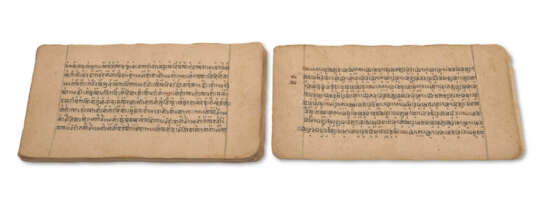ID 1053270
Lot 156 | Songbook of the Samaveda - The Veyagana
Estimate value
£ 2 000 – 3 000
Veyagāna (वेयगान), in Sanskrit, manuscript on paper, Toddapur, 1672
The Songbook of the Samaveda: a dated, complete copy of the Veyagāna.
141 x 288mm. In pothī format, 134 leaves, complete, marginal foliation, 8 lines with c.42 syllables a line, written in Sanskrit in a conservative Devanāgarī script in black ink, musical notation added as superscript, verse numbers and colophons highlighted with orange kunkuma pigment, borders lined in black ink (first leaf reinforced by card, a few repairs, a few stains and occasional fraying of edges). In a fitted burgundy cloth box.
Provenance:
(1) Vyāsacaturbhuja, son of Vyāsanarahari from ?Śrīmālā: colophon on the final leaf dated 1729 (1672 CE): In the year 1729 in the month of Phālguna on the second day of the waxing lunar fortnight. Today here in the city of Toddapura in the reign of King Anandasimha this book was written by Vyāsacaturbhuja, son of Vyāsanarahari from ?Śrīmālā. For his own benefit. For the benefit of others. Whether correct or incorrect, blame should not be apportioned to me. May it be auspicious. May it be pleasing. May it be so. It should be protected from oil, it should be protected from water and from loose binding, it must not be left to the rats: thus speaks out the manuscript.'
(2) Sam Fogg, Manuscripts from the Himalayas and the Indian Subcontinent, cat. 17 (1996), no 56.
(3) Schøyen Collection, MS 5293.
Text, script and music:
The Veyagāna, also known as the Grāmageyagāna, is one of the 4 gānas (song-books) of the liturgical Kauthuma Samhitā of the Sāmaveda, providing details of the particular melodies to be employed in the rendition of the sāmans. Both the Grāmageyagāna (detailing songs which can be practised in the village) and the Aranyagāna (containing esoteric songs meant for study in the forest), belong to the Purvārcikā, the first book of the Sāmaveda. The music notation goes back to the ancient Vedic period. The numbers above the text lines correspond to specific hand gestures from which the correct tone of the chant could be interpreted. The text of the present manuscript is written in a conservative Devanāgarī script, with e- and o-matras more often than not prefixed to consonants instead of superscript, and horizontal serifs slightly hooked in the manner of kutila scripts.
| Place of origin: | India |
|---|---|
| Auction house category: | Medieval & renaissance manuscripts |
| Place of origin: | India |
|---|---|
| Auction house category: | Medieval & renaissance manuscripts |
| Address of auction |
CHRISTIE'S 8 King Street, St. James's SW1Y 6QT London United Kingdom | ||||||
|---|---|---|---|---|---|---|---|
| Preview |
| ||||||
| Phone | +44 (0)20 7839 9060 | ||||||
| Buyer Premium | see on Website | ||||||
| Conditions of purchase | Conditions of purchase |



